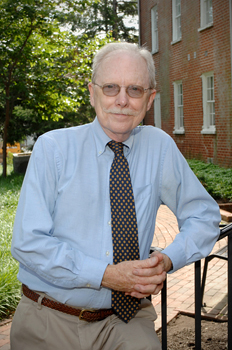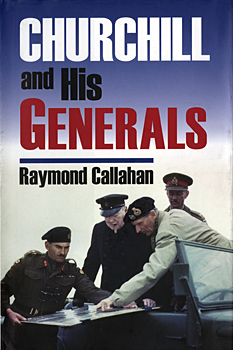The first and most urgent was the survival of his island nation in the midst of daily bombardment by air and the threat of invasion from German forces operating from occupied Europe.
The second challenge facing the legendary wartime leader was changing the beleaguered British Army from a force that seemed to be in constant retreat in the early days of the war to a fighting machine capable of taking the war to its enemies across the English Channel and around the world.
Why the British army found itself in such a situation early on and how it transformed itself into an effective fighting force by the end of the war is the subject of retired history professor Raymond Callahan's latest book, Churchill and His Generals, published by the University Press of Kansas.
Callahan taught at UD for 38 years and served as director of the Master of Liberal Studies (MALS) program and as associate dean of the College of Arts and Sciences. He still maintains a connection with the MALS program.
Callahan said that he hoped to demonstrate how Churchill had to balance the demands of empire and politics against the reality of the state of the British military, especially during the early years of the war.
“It doesn't change what will always be the bottom line about Winston Churchill, that he was exactly the leader that the British needed in 1940, and that without him they would not have made it through the war,” Callahan said. “I hope this will show how difficult it is in wartime to restructure an army while you also are fighting a war.”
Part of the problem with the British army's preparedness at the beginning of World War II, Callahan noted in Chapter I, “Legacies,” was that training tended to be from the top down, and that obedience, rather than initiative was favored, which resulted in a deliberate, reactive machine often characterized by regimental parochialism, with the result that it was involved in “a series of doomed campaigns that seemed to end with the Royal Navy plucking the remnants off beaches.”
“It is the story of an army that began the war unprepared and had to go through a very painful process of trial and error while learning the appropriate tactics and securing the right equipment,” Callahan said. “It also took quite a while for Churchill and his generals to realize that the British army of 1940-41 was not capable of delivering the results that everybody, including the prime minister, wanted. The process of adaptation meant that it was going to take time to rebuild, reequip and retrain the army.”
While general, and later field marshal Bernard Law Montgomery, or “Monty,” was perhaps the best known of the British military commanders of World War II, Callahan said that two men, one at the beginning of the war and one at its end, stand out as heroes deserving special recognition.
General the Viscount Lord Gort, VC, is, as Callahan notes, “a virtually forgotten man today, even in Britain.” It was Gort who decided to defy orders and make possible the evacuation of the 250,000-man British Expeditionary Force at Dunkirk in May 1940. The evacuated troops would form the basis of a rebuilding effort that would result in an army of 2 million men by the war's end in 1945.
“There are a lot of people in this story who did the best they could, but two stand out, including Gen. Lord Gort, who saved the core of the British Army by an act of enormous moral courage that inspired the entire nation,” Callahan said. “The other is Gen. William Slim, who simply was the finest British soldier of the war and the finest British military commander since Wellington.”

During World War II, the British Fourteenth Army was, in fact, a multinational force made up largely of units from the Indian Army, as well as West and East African divisions and regular British Army units. The Fourteenth Army repelled the Japanese invasion of India in 1944 and eventually drove the Japanese forces back across Burma, culminating with retaking the capital city of Rangoon on May 2, 1945.
“He was a very fine commander, and the Fourteenth Army veterans remained intensely loyal to him. He was at the end of the line for everything, and it was a horrendous theatre to fight in,” Callahan said. “He had to fight the Japanese and the climate and deal with Britain's ally, the United States, in the form of the prickly Gen. Joseph Stillwell. Still, he pulled off one of the great victories of the war.”
And, of course, there was Monty. The best known, and, Callahan said, perhaps the most hated of Britain's generals, Montgomery had nevertheless several things that favored his success, including the fact that he was a hard working professional who had a patron in General Sir Alan Brooke, CIGS (Chief of the Imperial General Staff), who supported him through thick and thin.
“El Alamein (1942) was the first really clear cut victory over Germany in the war, and as a result Montgomery became the best known and most publicized British general,” Callahan said. “He was shrewd enough to keep the press reasonably sweet, and he became a symbol of victory to the British public.”
What even the best generals in the British Army could not overcome was the dwindling manpower pool from which the army drew its recruits.
“The British didn't have the manpower numbers and fielded the smallest number of soldiers of the major combatants,” Callahan said. “The Americans had 100 divisions, the Russians had 300 divisions, while the British started with 55 divisions, which were scaled down to 17 fighting divisions by the time the war ended.”
Although Churchill and his generals may have had serious doubts as to the fighting qualities of the average British soldier during the seemingly unending series of defeats and retreats at the beginning of the war, the troops eventually proved to be every bit as tough as their fathers who had fought in World War I.
“The smart generals like Montgomery understood that you had to give these soldiers a sense that there was a purpose to what they were asked to do, and that their lives were not going to be squandered as carelessly as their fathers had been,” Callahan said. “There was a sense among these people that they would finish the job, and that their reward would not be knowing that the empire survived, but that the country would be restructured to give them a better life.”
Calllahan, the recipient of a UD excellence-in-teaching award, also was a visiting professor of military history at the U.S. Army Command General Staff College and has lectured at other war colleges. Other books by Callahan include The Worst Disaster: The Fall of Singapore, Burma 1942-45 and Churchill: Retreat from Empire.
Article by Jerry Rhodes
Photo by Kathy F. Atkinson



